TOYOTA AVALON HYBRID 2019 Owners Manual (in English)
Manufacturer: TOYOTA, Model Year: 2019, Model line: AVALON HYBRID, Model: TOYOTA AVALON HYBRID 2019Pages: 556, PDF Size: 9.73 MB
Page 441 of 556
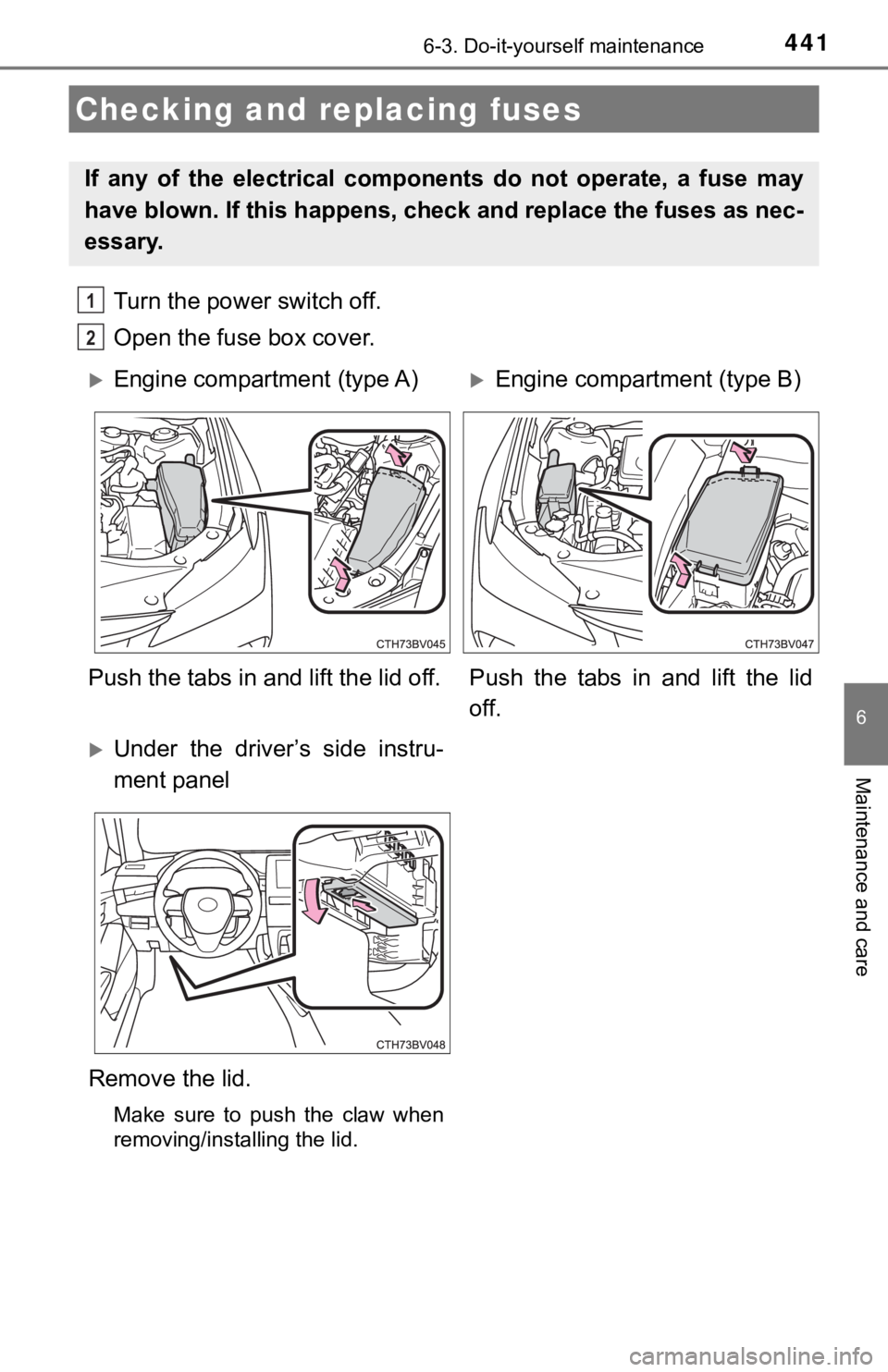
4416-3. Do-it-yourself maintenance
6
Maintenance and care
Turn the power switch off.
Open the fuse box cover.
Checking and replacing fuses
If any of the electrical components do not operate, a fuse may
have blown. If this happens, check and replace the fuses as nec-
essary.
1
2
Engine compartment (type A)Engine compartm ent (type B)
Push the tabs in and lift the lid off. Push the tabs in and lift the lid
off.
Under the driver’s side instru-
ment panel
Remove the lid.
Make sure to push the claw when
removing/installing the lid.
Page 442 of 556
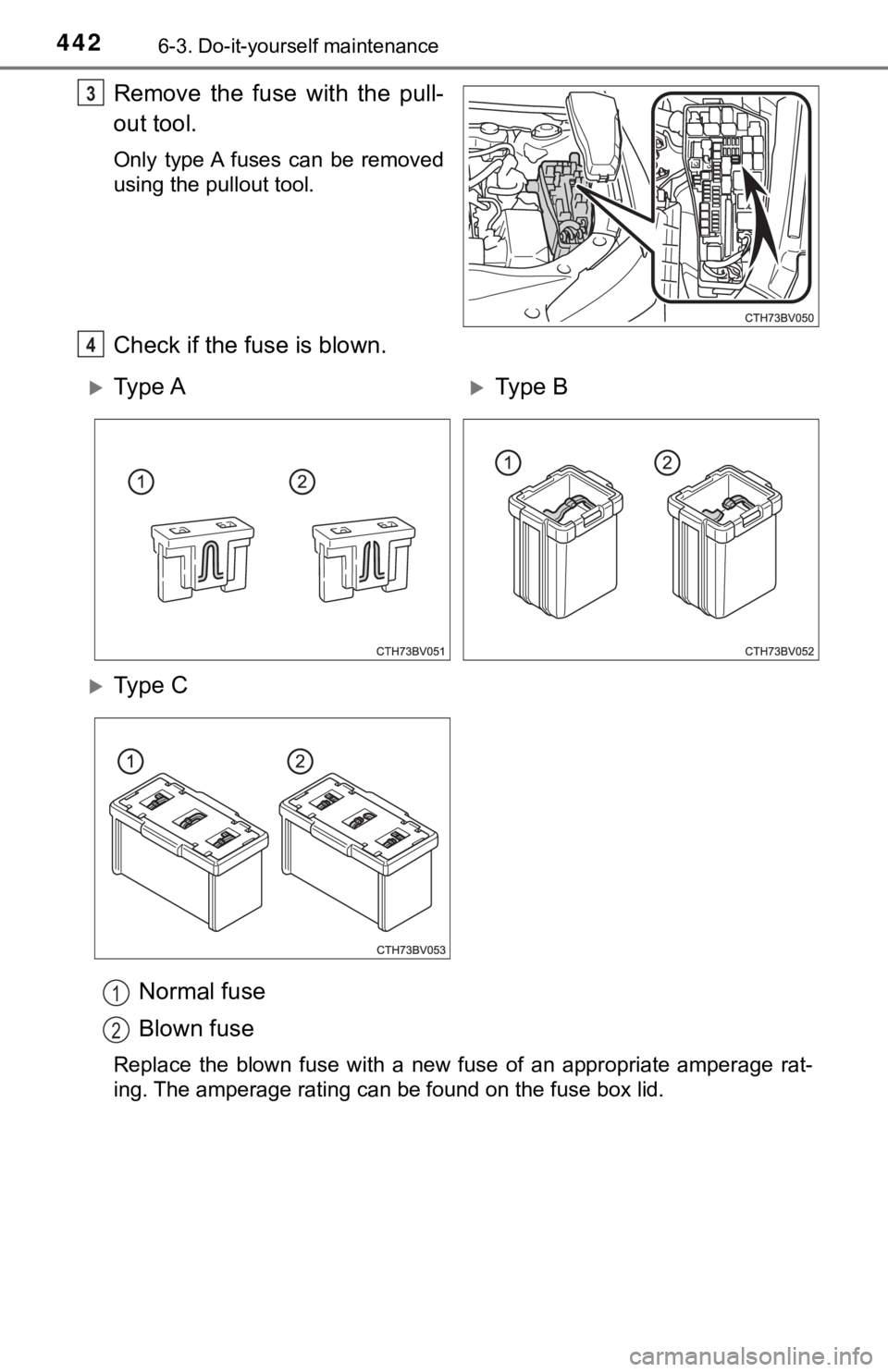
4426-3. Do-it-yourself maintenance
Remove the fuse with the pull-
out tool.
Only type A fuses can be removed
using the pullout tool.
Check if the fuse is blown.Normal fuse
Blown fuse
Replace the blown fuse with a new fuse of an appropriate ampera ge rat-
ing. The amperage rating can be found on the fuse box lid.
3
4
Ty p e AType B
Ty p e C
1
2
Page 443 of 556
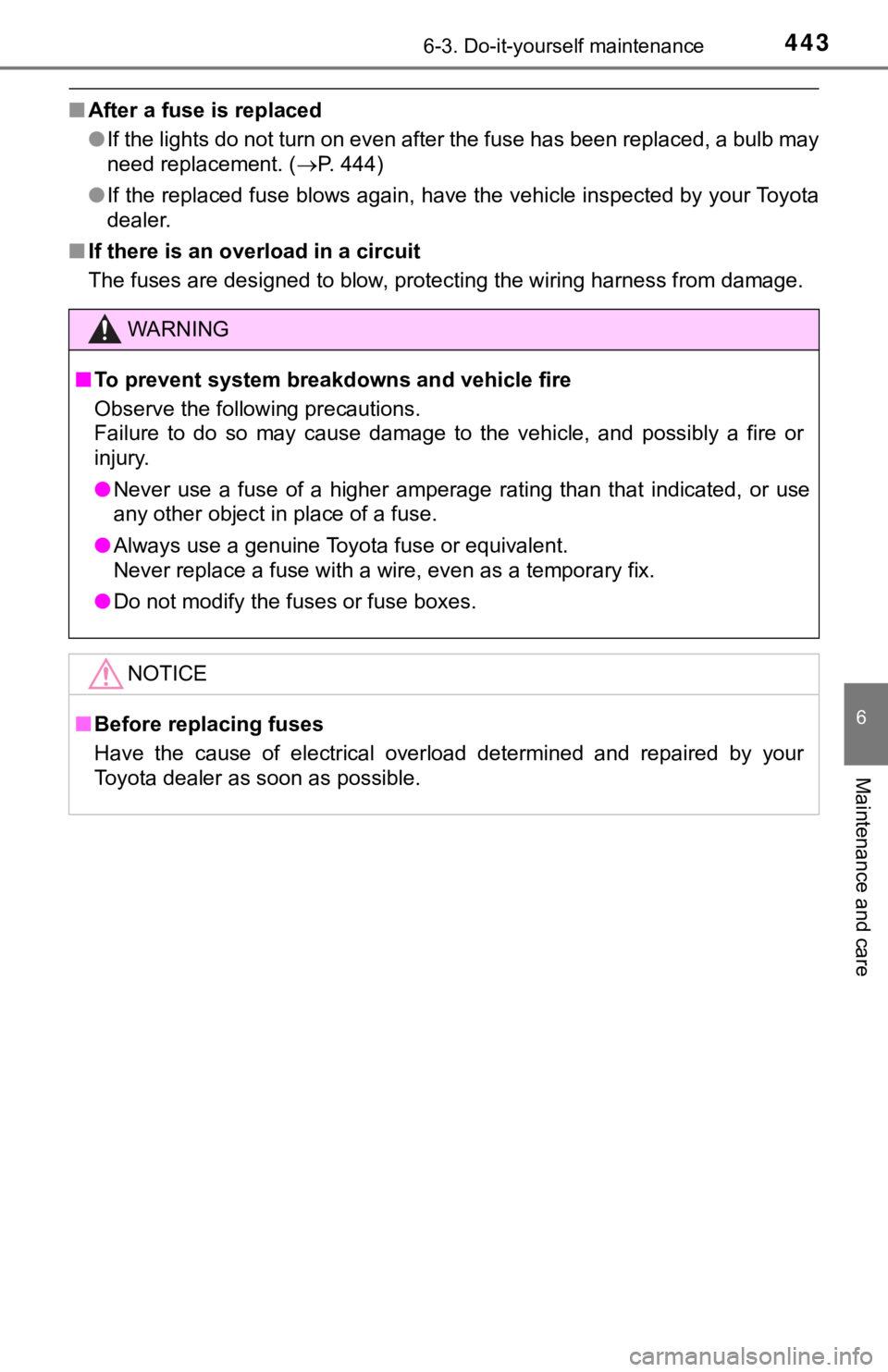
4436-3. Do-it-yourself maintenance
6
Maintenance and care
■After a fuse is replaced
●If the lights do not turn on even after the fuse has been repla ced, a bulb may
need replacement. ( P. 444)
● If the replaced fuse blows again, have the vehicle inspected by your Toyota
dealer.
■ If there is an overload in a circuit
The fuses are designed to blow, protecting the wiring harness f rom damage.
WARNING
■To prevent system breakdowns and vehicle fire
Observe the following precautions.
Failure to do so may cause damage to the vehicle, and possibly a fire or
injury.
● Never use a fuse of a higher amperage rating than that indicate d, or use
any other object in place of a fuse.
● Always use a genuine Toyota fuse or equivalent.
Never replace a fuse with a wire, even as a temporary fix.
● Do not modify the fuses or fuse boxes.
NOTICE
■Before replacing fuses
Have the cause of electrical overload determined and repaired b y your
Toyota dealer as soon as possible.
Page 444 of 556
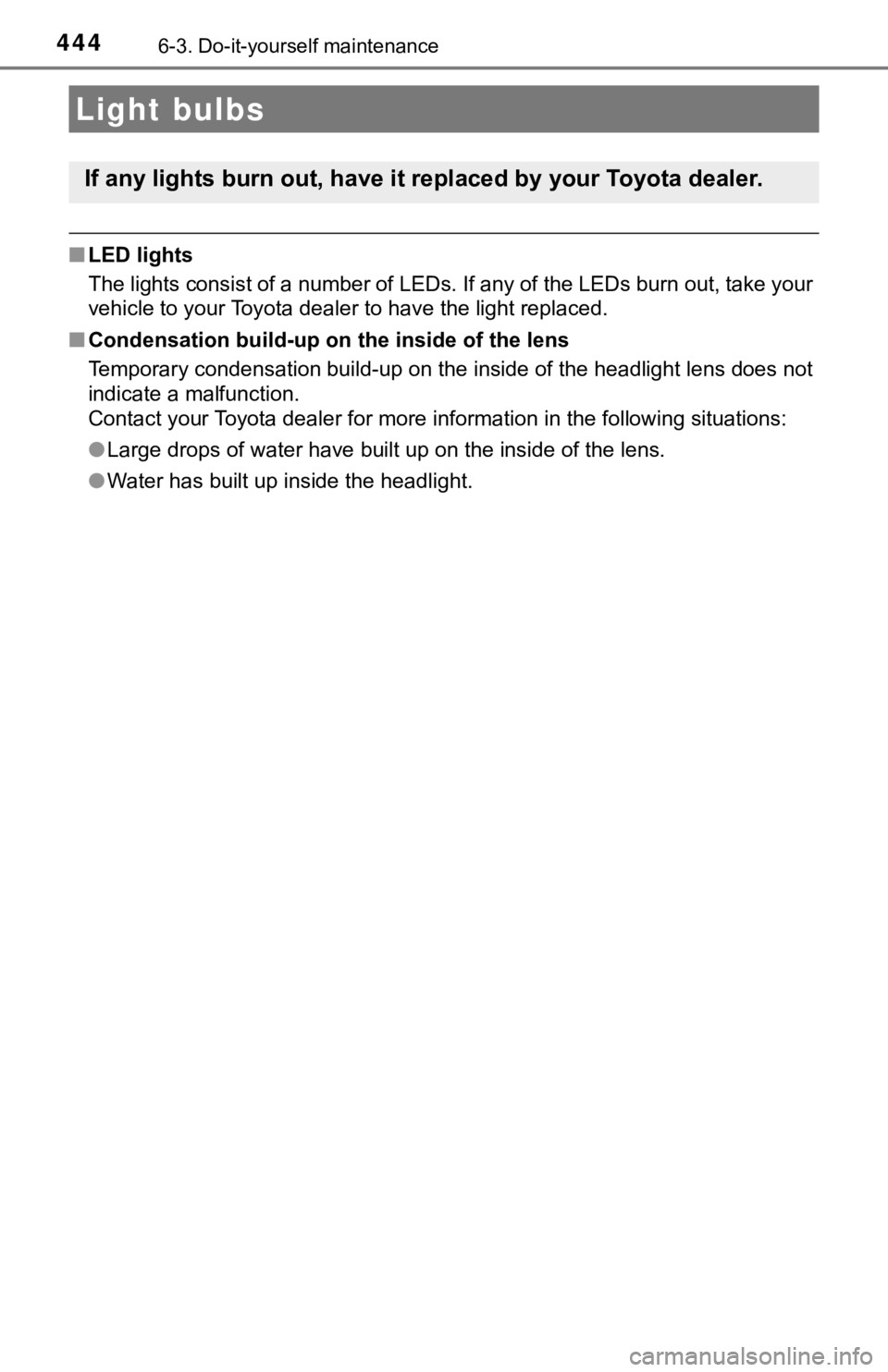
4446-3. Do-it-yourself maintenance
■LED lights
The lights consist of a number of LEDs. If any of the LEDs burn out, take your
vehicle to your Toyota dealer to have the light replaced.
■ Condensation build-up on the inside of the lens
Temporary condensation build-up on the inside of the headlight lens does not
indicate a malfunction.
Contact your Toyota dealer for more information in the followin g situations:
● Large drops of water have built up on the inside of the lens.
● Water has built up inside the headlight.
Light bulbs
If any lights burn out, have it replaced by your Toyota dealer.
Page 445 of 556

445
7When trouble arises
7-1. Essential informationEmergency flashers .......... 446
If your vehicle has to be stopped in an
emergency ...................... 447
7-2. Steps to take in an emergency
If your vehicle needs to be towed ..................... 448
If you think something is wrong .......................... 451
If a warning light turns on or a warning buzzer
sounds ............................ 452
If a warning message is displayed ..................... 462
If you have a flat tire.......... 468
If the hybrid system will not start ..................... 479
If the electronic key does not operate
properly ........................... 481
If the 12-volt battery is discharged ................... 484
If your vehicle overheats ........................ 491
If the vehicle becomes stuck ................ 495
Page 446 of 556
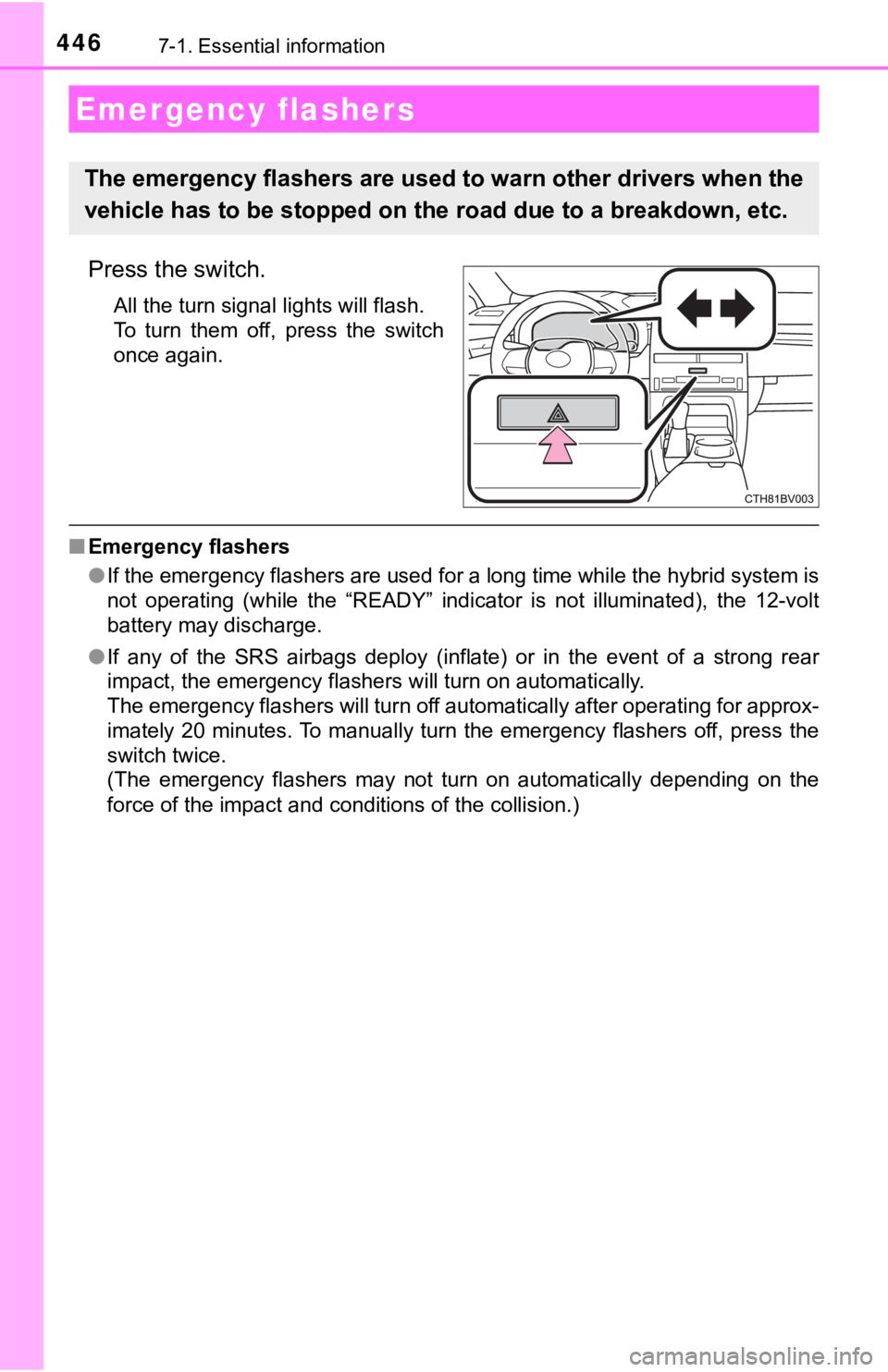
4467-1. Essential information
Press the switch.
All the turn signal lights will flash.
To turn them off, press the switch
once again.
■Emergency flashers
●If the emergency flashers are used for a long time while the hy brid system is
not operating (while the “READY” indicator is not illuminated), the 12-volt
battery may discharge.
● If any of the SRS airbags deploy (inflate) or in the event of a strong rear
impact, the emergency flashers will turn on automatically.
The emergency flashers will turn off automatically after operat ing for approx-
imately 20 minutes. To manually turn the emergency flashers off, press the
switch twice.
(The emergency flashers may not turn on automatically depending on the
force of the impact and conditions of the collision.)
Emergency flashers
The emergency flashers are used to warn other drivers when the
vehicle has to be stopped on the road due to a breakdown, etc.
Page 447 of 556
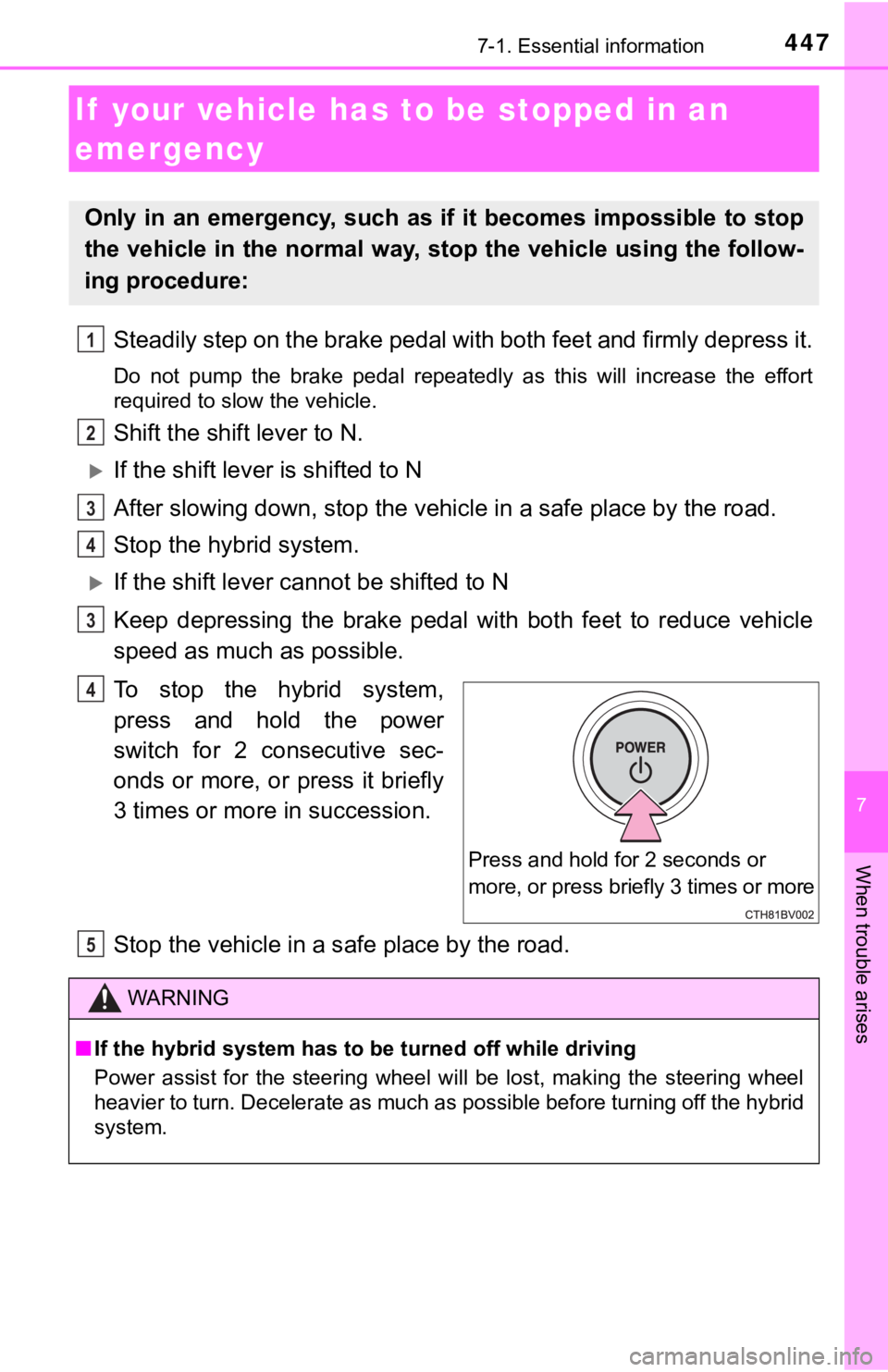
4477-1. Essential information
7
When trouble arises
Steadily step on the brake pedal with both feet and firmly depress it.
Do not pump the brake pedal repeatedly as this will increase th e effort
required to slow the vehicle.
Shift the shift lever to N.
If the shift lever is shifted to N
After slowing down, stop the vehi cle in a safe place by the road.
Stop the hybrid system.
If the shift lever cann ot be shifted to N
Keep depressing the brake pedal with both feet to reduce vehicl e
speed as much as possible.
To stop the hybrid system,
press and hold the power
switch for 2 consecutive sec-
onds or more, or press it briefly
3 times or more in succession.
Stop the vehicle in a s afe place by the road.
If your vehicle has to be stopped in an
emergency
Only in an emergency, such as if it becomes impossible to stop
the vehicle in the normal way, st op the vehicle using the follow-
ing procedure:
1
2
3
4
3
Press and hold for 2 seconds or
more, or press briefly 3 times or more
Q
WARNING
■ If the hybrid system has to b e turned off while driving
Power assist for the steering wheel will be lost, making the st eering wheel
heavier to turn. Decelerate as m uch as possible before turning off the hybrid
system.
5
Page 448 of 556
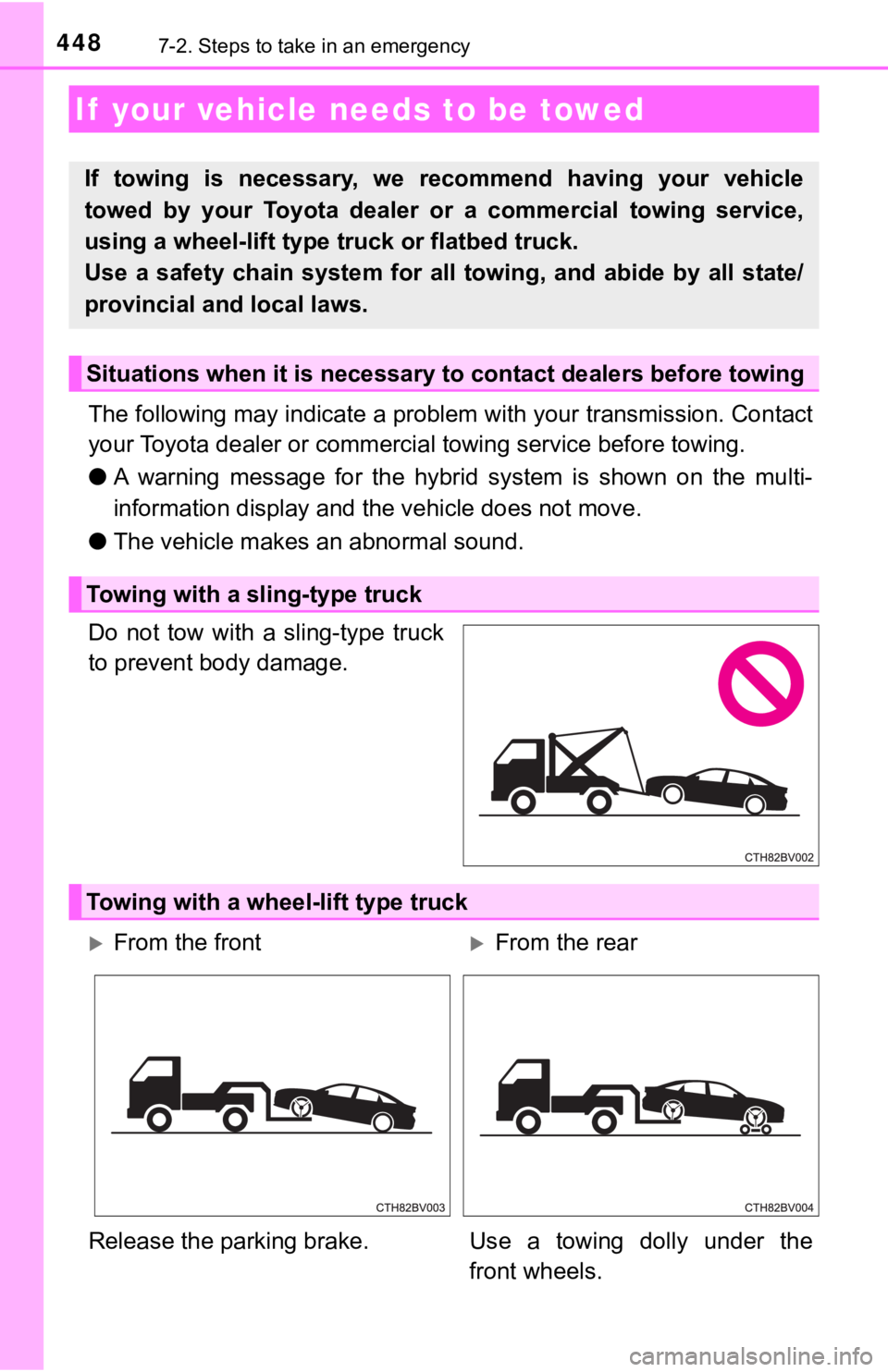
4487-2. Steps to take in an emergency
The following may indicate a problem with your transmission. Contact
your Toyota dealer or commercial towing service before towing.
● A warning message for the hybrid system is shown on the multi-
information display and the vehicle does not move.
● The vehicle makes an abnormal sound.
Do not tow with a sling-type truck
to prevent body damage.
If your vehicle needs to be towed
If towing is necessary, we recommend having your vehicle
towed by your Toyota dealer or a commercial towing service,
using a wheel-lift type t ruck or flatbed truck.
Use a safety chain system for all towing, and abide by all stat e/
provincial and local laws.
Situations when it is necessary to contact dealers before towing
Towing with a sling-type truck
Towing with a wheel-lift type truck
From the frontFrom the rear
Release the parking brake. Us e a towing dolly under the
front wheels.
Page 449 of 556
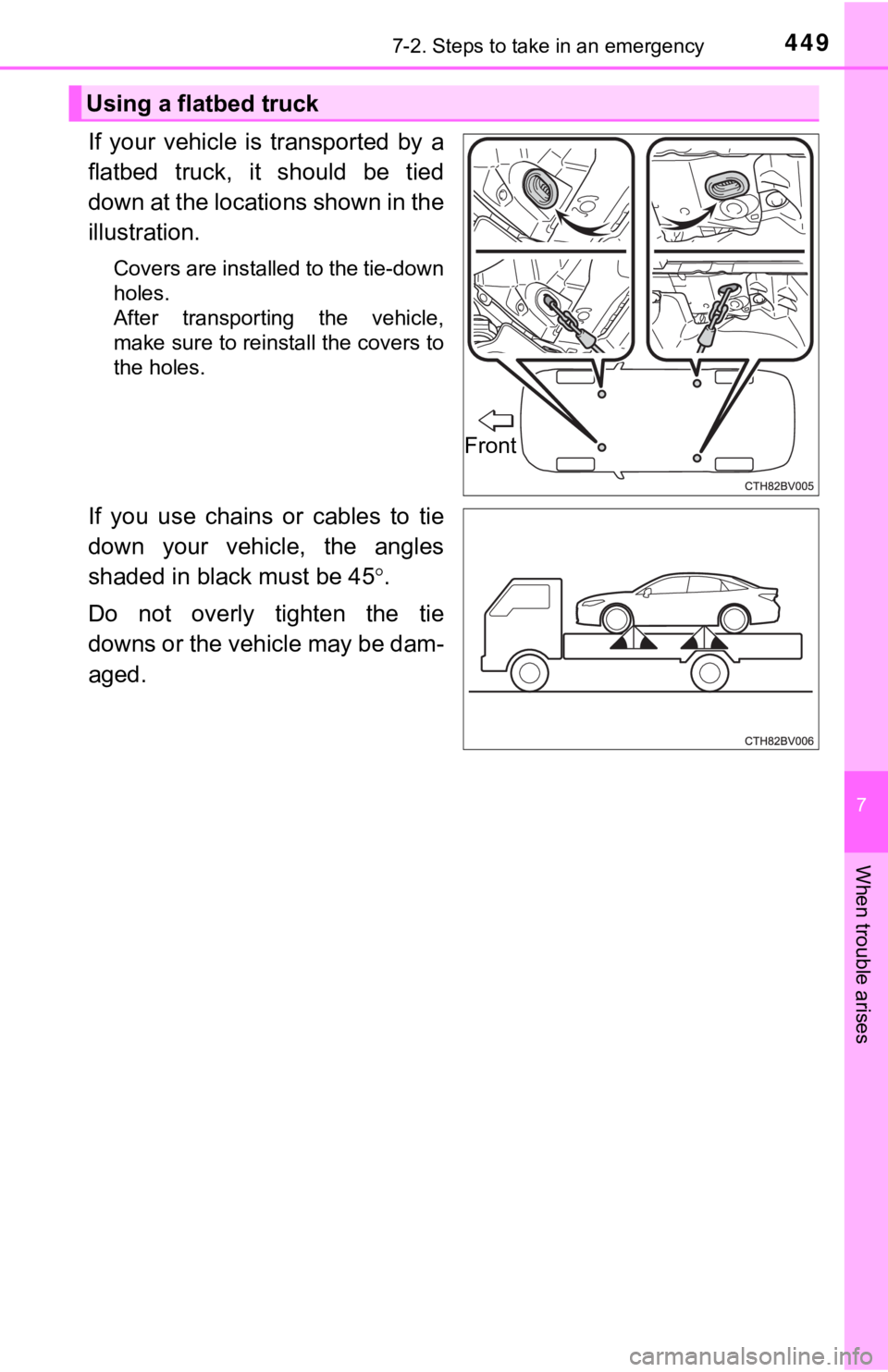
4497-2. Steps to take in an emergency
7
When trouble arises
If your vehicle is transported by a
flatbed truck, it should be tied
down at the locations shown in the
illustration.
Covers are installed to the tie-down
holes.
After transporting the vehicle,
make sure to reinstall the covers to
the holes.
If you use chains or cables to tie
down your vehicle, the angles
shaded in black must be 45.
Do not overly tighten the tie
downs or the vehicle may be dam-
aged.
Using a flatbed truck
Front
Page 450 of 556
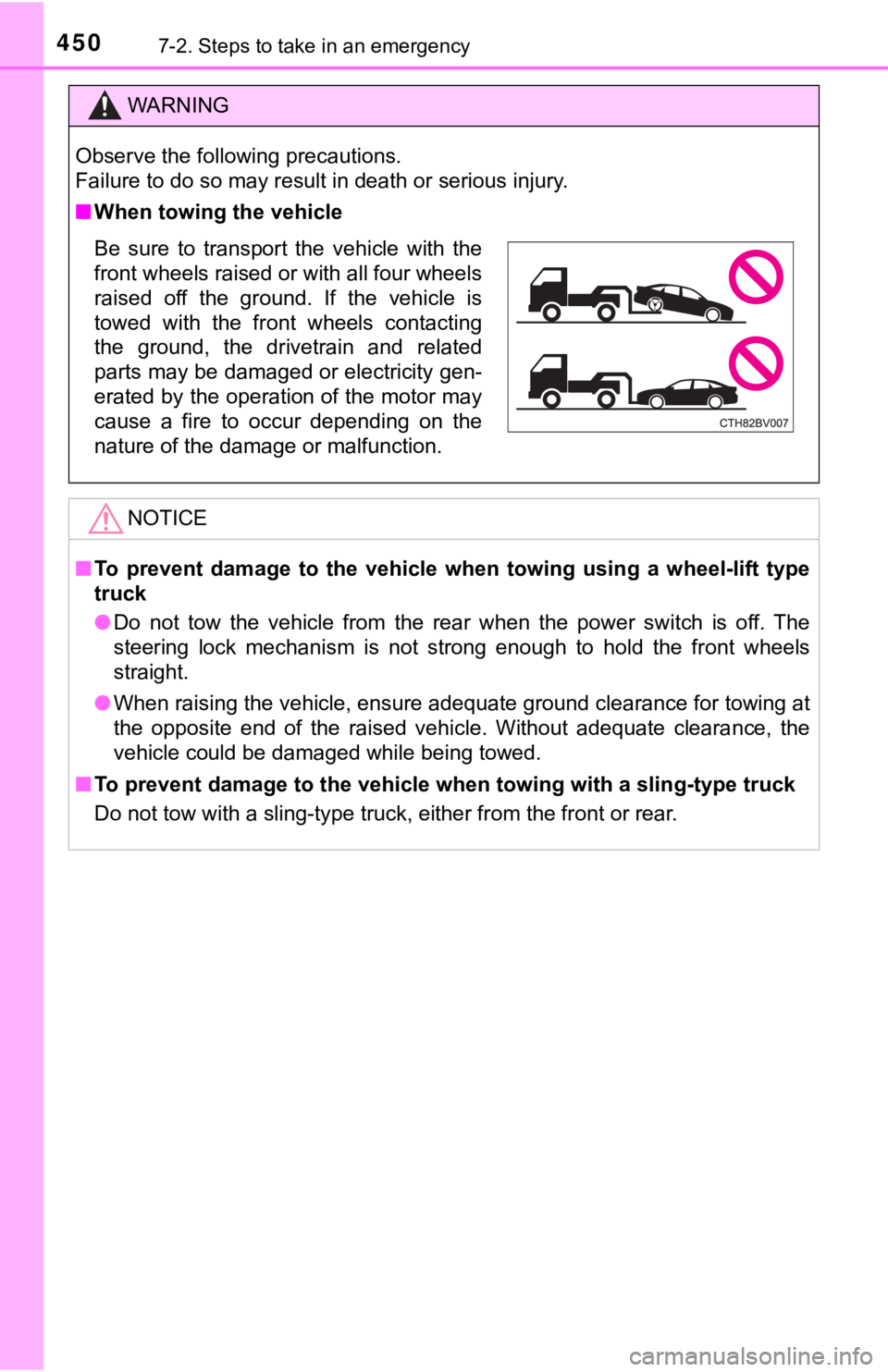
4507-2. Steps to take in an emergency
WARNING
Observe the following precautions.
Failure to do so may result in death or serious injury.
■When towing the vehicle
NOTICE
■To prevent damage to the vehicle when towing using a wheel-lift type
truck
● Do not tow the vehicle from the rear when the power switch is o ff. The
steering lock mechanism is not strong enough to hold the front wheels
straight.
● When raising the vehicle, ensure adequate ground clearance for towing at
the opposite end of the raised vehicle. Without adequate clearance, the
vehicle could be damaged while being towed.
■ To prevent damage to the vehicle when towing with a sling-type truck
Do not tow with a sling-type truck, either from the front or re ar.
Be sure to transport the vehicle with the
front wheels raised or with all four wheels
raised off the ground. If the vehicle is
towed with the front wheels contacting
the ground, the drivetrain and related
parts may be damaged or electricity gen-
erated by the operation of the motor may
cause a fire to occur depending on the
nature of the damage or malfunction.